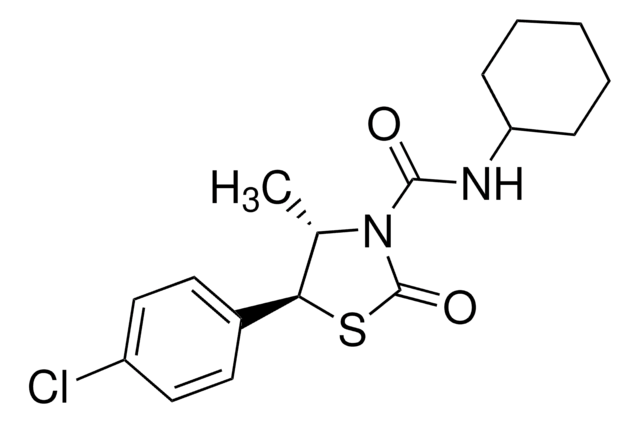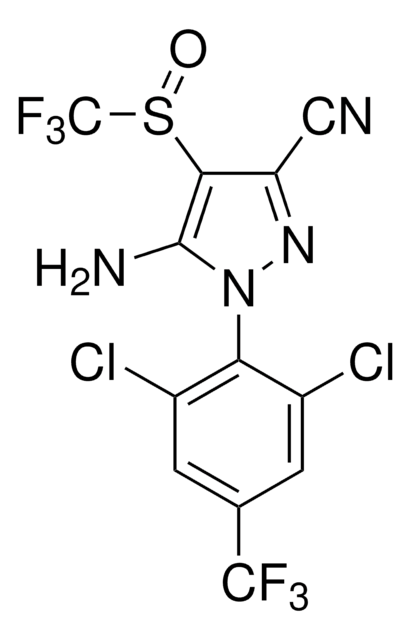68694
Imidacloprid
certified reference material, TraceCERT®, Manufactured by: Sigma-Aldrich Production GmbH, Switzerland
About This Item
Recommended Products
grade
certified reference material
TraceCERT®
Quality Level
product line
TraceCERT®
shelf life
limited shelf life, expiry date on the label
manufacturer/tradename
Manufactured by: Sigma-Aldrich Production GmbH, Switzerland
technique(s)
gas chromatography (GC): suitable
application(s)
agriculture
environmental
format
neat
SMILES string
[O-][N+](=O)NC1=NCCN1Cc2ccc(Cl)nc2
InChI
1S/C9H10ClN5O2/c10-8-2-1-7(5-12-8)6-14-4-3-11-9(14)13-15(16)17/h1-2,5H,3-4,6H2,(H,11,13)
InChI key
YWTYJOPNNQFBPC-UHFFFAOYSA-N
Looking for similar products? Visit Product Comparison Guide
Related Categories
General description
Find more information here: Neonicotinoids
Certified content by quantitative NMR incl. uncertainty and expiry date are given on the certificate.
Download your certificate at: http://www.sigma-aldrich.com.
Application
- Removal of neonicotinoids from wastewater: A study highlighted ferrate(VI)-based oxidation processes for removing neonicotinoids, including imidacloprid, from secondary effluents, suggesting a potential method for reducing environmental contamination from these chemicals (Real et al., 2024).
- Resistance patterns in sheep blowflies: A study on in vitro insecticide resistance patterns in field strains of the sheep blowfly, Lucilia cuprina, included assessments of resistance to imidacloprid, providing insights into the development and spread of resistance in pest populations (Kotze et al., 2024).
- Synergized insecticidal toxicity and risk reduction: The development of mesoporous silica nanospheres for the co-delivery of insecticides and antibiotics was studied to enhance the insecticidal efficacy of substances like imidacloprid while minimizing their environmental impact (Lv et al., 2024).
- Alternative bio-insecticides against greenhouse pests: The efficacy of tangerine peel extracts as a bio-insecticide against Trialeurodes vaporariorum was evaluated, offering a potential alternative to chemical insecticides such as imidacloprid in agricultural pest control (Flores et al., 2024).
Recommended products
Legal Information
Signal Word
Danger
Hazard Statements
Precautionary Statements
Hazard Classifications
Acute Tox. 3 Oral - Aquatic Acute 1 - Aquatic Chronic 1
Storage Class Code
6.1C - Combustible acute toxic Cat.3 / toxic compounds or compounds which causing chronic effects
WGK
WGK 2
Flash Point(F)
Not applicable
Flash Point(C)
Not applicable
Choose from one of the most recent versions:
Certificates of Analysis (COA)
Don't see the Right Version?
If you require a particular version, you can look up a specific certificate by the Lot or Batch number.
Already Own This Product?
Find documentation for the products that you have recently purchased in the Document Library.
Customers Also Viewed
Protocols
Learn more about Neonicotinoids - active substances used in plant protection products to control harmful insects.
Learn more about Neonicotinoids - active substances used in plant protection products to control harmful insects.
Learn more about Neonicotinoids - active substances used in plant protection products to control harmful insects.
Learn more about Neonicotinoids - active substances used in plant protection products to control harmful insects.
Our team of scientists has experience in all areas of research including Life Science, Material Science, Chemical Synthesis, Chromatography, Analytical and many others.
Contact Technical Service












